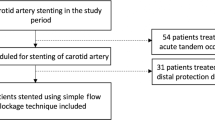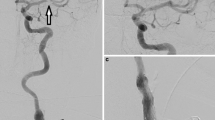Abstract
Since intraluminal thrombus in the context of carotid artery stenosis is rarely encountered, treatment for this condition remains controversial. The present paper describes six cases of carotid artery stenosis with thrombus and discusses the efficacy and complications of carotid artery stenting (CAS). From April 2002 to May 2004, six patients with carotid artery stenosis and intraluminal thrombus receiving medical therapy underwent CAS at our institution. CAS was performed with distal protection alone (method 1) in three patients, and three other patients underwent CAS with reversed-flow system and distal protection (method 2). Two of six patients experienced worsening neurologic symptoms despite medical therapy. All six patients were successfully treated with CAS and showed satisfactory patency of the artery. Embolic lesions were detected on diffusion-weighted MRI after the procedure in all patients treated with method 1 but not in patients treated with method 2. Complications included stent thrombosis (n=1) and in-stent thrombus (n=1). All six patients achieved a modified Rankin Scale 1 or 2 classification at 30 days after stenting. In conclusion, CAS was feasible for stenosis even with intraluminal thrombus. Use of method 2 for this condition may reduce the incidence of thromboembolic events although our series was small in number.




Similar content being viewed by others
References
Endo S, Hirashima Y, Kurimoto M et al (1996) Acute pathologic features with angiographic correlates of the nearly or completely occluded lesions of the cervical internal carotid artery. Surg Neurol 46:222–228
Biller J, Adams HP Jr, Boarini D et al (1986) Intraluminal clot of the carotid artery: a clinical-angiographic correlation of nine patients and literature review. Surg Neurol 25:467–477
North American symptomatic carotid endarterectomy trial collaborators (1991) Beneficial effect of carotid endarterectomy in symptomatic patients with high-grade carotid stenosis. N Eng J Med 325:445–453
Villarreal J, Silva J, Eliasziw M et al (1998) Prognosis of patients with intraluminal thrombus in the internal carotid artery. Stroke 29:276
Buchan A, Gates P, Pelz D et al (1998) Intraluminal thrombus in the cerebral circulation: implications for surgical management. Stroke 19:681–687
Walters BB, Ojemann RG, Heros RC (1987) Emergency carotid endarterectomy. J Neurosurg 66:817–823
Yadav J (2002) Stenting and angioplasty with protection in patients at high risk for endarterectomy (The SAPPHIRE Study). AHA Scientific Sessions. November 2002, Chicago IL
Gonzalez A, Mayol A, Gil-Peralta A et al (2004) Angioplasty of symptomatic high-grade internal carotid artery stenosis with intraluminal thrombus: therapeutic approach. Neuroradiology 46:313–317
Ohki T, Parodi J, Veith FJ et al (2001) Efficacy of a proximal occlusion catheter with reversal of flow in the prevention of embolic events during carotid artery stenting: an experimental analysis. J Vasc Surg 33:504–509
Parodi J, Schonholz C, Ferreira LM et al (2002) “Seat belt and air bag” technique for cerebral protection during carotid stenting. J Endovasc Ther 9:20–24
Terada T, Tsuura M, Matsumoto H et al (2003) Results of endovascular treatment of internal carotid artery stenoses with a newly developed balloon protection catheter. Neurosurgery 53:617–625
Whitlow P, Lylyk P, Londero H et al (2002) Carotid artery stenting protected with an emboli containment system. Stroke 33:1308–1314
Chaturvedi S, Sohrab S, Tselis A (2001) Carotid stent thrombosis: report of 2 fetal cases. Stroke 32:2700–2702
Hamann GF, Liebetrau M, Pfefferkorn T et al (2002) Successful systemic thrombolysis for carotid stent thrombosis. Eur Neurol 48:37–39
Baim DS, Carrozza JP Jr (1997) Stent thrombosis. Closing in on the best preventive treatment. Circulation 95:1098–1100
New G, Roubin GS, Iyer SS et al (1999) Carotid artery stenting: rationale, indications, and results. Compr Ther 25:438–445
Wholey MH, Wholey M, Mathias K et al (2000) Global experience in cervical carotid artery stent placement. Cathet Cardiovasc Interv 50:160–167
Junghans U, Siebler M (2003) Cerebral microembolism is blocked by tirofiban, a selective nonpeptide platelet glycoprotein IIb/IIIa receptor antagonist. Circulation 107:2717–2721
Author information
Authors and Affiliations
Corresponding author
Rights and permissions
About this article
Cite this article
Tsumoto, T., Terada, T., Tsuura, M. et al. Carotid artery stenting for stenosis with intraluminal thrombus. Neuroradiology 48, 54–59 (2006). https://doi.org/10.1007/s00234-005-0015-6
Received:
Accepted:
Published:
Issue Date:
DOI: https://doi.org/10.1007/s00234-005-0015-6




